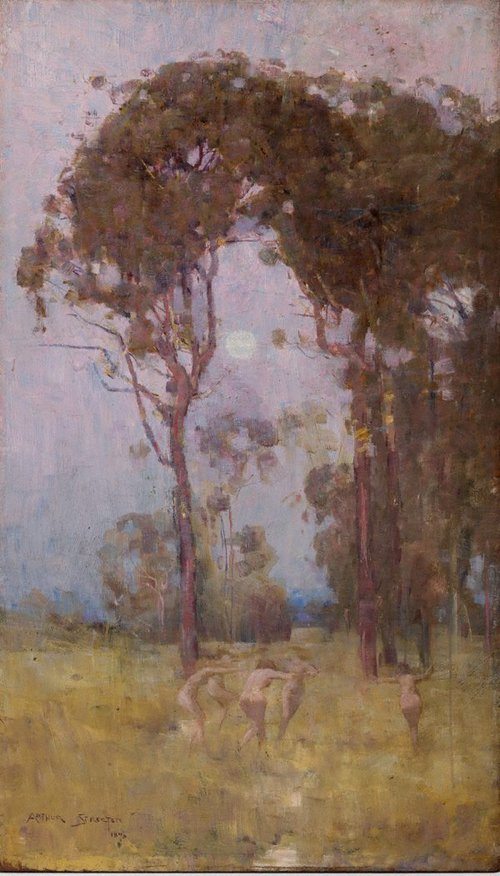Title
Blue Mountains
1891
Artist
-
Details
- Other Titles
- Blasting on Blue Mountains
Sketch for Fire's On
Sketch-Blue Mountains
Cutting a tunnel, Blue Mountains
Sketch for Blue Mountains - Place where the work was made
-
Lapstone
→
New South Wales
→
Australia
- Date
- 1891
- Media category
- Watercolour
- Materials used
- pencil, watercolour, opaque white on ivory wove paper on board
- Dimensions
- 34.2 x 23.5 cm (irreg.) sheet, 34.6 x 24.1 cm board
- Signature & date
Signed l.r., brown watercolour "A Streeton". Dated dated l.l., brown watercolour "91".
- Credit
- Purchased with funds provided by Don Mitchell Bequest Fund and the Australian Prints, Drawings and Watercolours Benefactors' Fund 2014
- Location
- Not on display
- Accession number
- 99.2014
- Copyright
- Artist information
-
 Arthur Streeton
Arthur Streeton
Works in the collection
- Share
-
-
About
In late 1891, Streeton spent about 2-3 months living at Glenbrook, in the Blue Mountains, when he painted his iconic masterpiece, 'Fire's on' (Art Gallery of New South Wales collection). 'Fire's on' was the cry of the workers, who were cutting a railway tunnel through the mountains at Lapstone, just before a blast was detonated.
In a letter to Tom Roberts dated October 1891, Streeton wrote: I've been pegging on at my work between the 'blasts'- & have not been here a fortnight - & have done two w.colour gems - besides a number of sketches - & can do very little more to em strikes me" (Ann Galbally and Anne Gray (editors), 'Letters from Smike: the letters of Arthur Streeton 1890 - 1943', Oxford University Press, Melbourne, 1989, p 36).
The tunnel project was a major feat of engineering and was at the time considered 'one of the greatest wonders of the colony - perhaps it may be said - of the world' (Josiah Hughes, 'Australia revisited in 1890', quoted in Jane Clark and Bridget Whitelaw, 'Golden Summers: Heidelberg and beyond', International Cultural Corporation of Australia and National Gallery of Victoria, Melbourne, 1985, p 140). Streeton wrote with great enthusiasm of his time there spent painting, observing the work and the workers themselves. What a boom of thunder shakes the rock and me. It echoes through the hills and dies away 'mid the crashing of tons of rock; some lumps fly hundreds of feet sometimes and fall and fly everywhere among the trees; and then a thick cloud laden with fumes of the blasting powder (Streeton to Frederick McCubbin, October 1891, see 'Golden Summers' p 140)
This watercolour gives the impression of having been executed quickly en plein air, capturing a dramatic moment. The landscape is notational, with the trees in particular having elegant fluidity. The picture plane is compressed, the palette limited and relatively subdued (possibly suggesting it was painted at a different time of day). There is a strong focus on the moment of the blast, with a flurry of opaque white pigment at the centre of the composition, capturing the energy of the explosion as it detonates from the rock face.
-
Exhibition history
Shown in 4 exhibitions
Victorian Artists Society exhibition of paintings, sculpture & drawings (1982), Victorian Artists Society, Melbourne, May 1892–Unknown
Society of Artists, South Australia (1893), South Australian Society of Artists, Australia, 22 Sep 1983–07 Oct 1983
Golden Summers - Heidelberg and beyond, National Gallery of Victoria [St Kilda Road], Melbourne, 30 Oct 1985–27 Jan 1986
Golden Summers - Heidelberg and beyond, Art Gallery of New South Wales, Sydney, 21 Feb 1986–20 Apr 1986
Golden Summers - Heidelberg and beyond, Art Gallery of South Australia, Adelaide, 09 May 1986–29 Jun 1986
Golden Summers - Heidelberg and beyond, Art Gallery of Western Australia, Perth, 30 Jul 1986–14 Sep 1986
Streeton, Art Gallery of New South Wales, Sydney, 07 Nov 2020–14 Feb 2021
-
Bibliography
Referenced in 9 publications
-
Michael Brand, Look, 'From the Gallery director', pg. 13, Sydney, Sep 2014, 13, 14, 15 (colour illus.).
-
Jane Clark and Bridget Whitelaw, Golden summers: Heidelberg and beyond, Melbourne, 1985, 140. general reference by the artist to 'two watercolour gems'
-
Ann Galbally, Letters from Smike: the letters of Arthur Streeton, 1890-1943, 'Chapter 2: 1981' edited, pg. 26-41, Melbourne, 1989, 36, 37, 38. general reference to 'Blue Mountains' being one of a series of 'sketches' by the artist
-
Jeff Rigby., Oz Arts magazine [issue 9], 'Fire's on: the circumstances surrounding the painting by Arthur Streeton of 'Fire's on!' and the Lapstone railway tunnel deviation of 1891', Wentworth Falls, Spring 2016, (colour illus.).
-
Geoffrey Smith, Arthur Streeton, 1867-1943, South Yarra, 1995, 82, 84. general reference to 'Blue Mountains' as one of 'several sketches' made by artist
-
South Australian Society of Artists, South Australian Society of Arts 1893 Exhibition, Adelaide, 1893, 9. titled 'Blasting on Blue Mountains, N.S.W.'; cat.no. 101
-
Clare Temple, Foundation Newsletter #24, 'Curators' and coordinators' reports', pg. 8-11, Sydney, Jul 2014, 10 (colour illus.).
-
Victorian Artists Society (Compilator), Victorian Artists Society exhibition of paintings, sculptures & drawings illustrated catalogue, Melbourne, May 1892, 30. either 'Sketch-Blue Mountains' cat.no. 234 or 'Cutting a tunnel (sketch), Blue Mountains' cat.no. 238
-
Editor Unknown (Editor), Argus, 'The Victorian Society of Artists. Annual exhibition', pg. 7, Melbourne, 30 May 1892, 7. titled 'Cutting a tunnel, Blue Mountains'.
-





